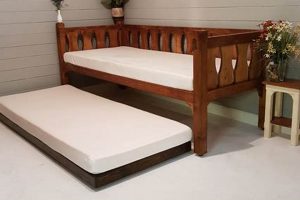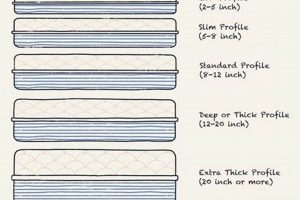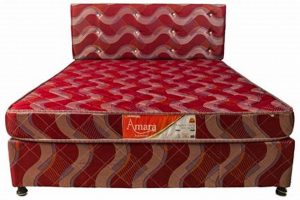Enhancing the sleep surface of a convertible couch addresses the inherent limitations of its design. These multi-functional furniture pieces, while space-saving, often compromise on comfort due to the thinner mattress and supporting frame. Improving the sleep experience involves mitigating these factors to provide a more restful night.
A more comfortable sleep surface promotes better rest, positively impacting overall health and well-being. Historically, solutions to this challenge have ranged from simple padding additions to sophisticated memory foam enhancements. Addressing the issue of inadequate support extends the usability of these pieces, preventing premature replacement and reducing waste.
Therefore, strategies to optimize convertible couch sleep surfaces are explored in the subsequent sections, focusing on practical and cost-effective solutions. These include selecting appropriate mattress toppers, addressing underlying support issues, and implementing techniques for improved temperature regulation during sleep.
Strategies for Optimizing Convertible Couch Sleep Surfaces
This section outlines several approaches to improving the comfort of a convertible couch mattress. Addressing common issues such as thinness, inadequate support, and temperature regulation can significantly enhance the sleep experience.
Tip 1: Invest in a High-Quality Mattress Topper: A memory foam or latex topper provides additional cushioning and support, offsetting the firmness often associated with convertible couch mattresses. The thickness should be carefully selected, considering the folding mechanism’s constraints.
Tip 2: Address Underlying Support Deficiencies: Examine the supporting frame for sagging or unevenness. Adding plywood sheets beneath the mattress can provide a more stable and consistent surface. Ensure proper ventilation to prevent moisture buildup.
Tip 3: Utilize a Mattress Pad for Temperature Regulation: A breathable mattress pad can help regulate body temperature during sleep, mitigating overheating. Materials such as cotton or bamboo are recommended for their moisture-wicking properties.
Tip 4: Employ Fitted Sheets for a Secure Fit: Ill-fitting sheets can bunch up and create discomfort. Fitted sheets designed for the specific dimensions of the convertible couch mattress are essential for a smooth and secure sleep surface.
Tip 5: Consider a Replacement Mattress (If Feasible): If the existing mattress is severely worn or of exceptionally low quality, exploring a replacement mattress that adheres to the convertible couch’s size constraints may prove beneficial. Prioritize mattresses with higher coil counts or denser foam for improved support.
Tip 6: Rotate the Mattress Regularly: Rotating the mattress periodically can help distribute wear and tear evenly, extending its lifespan and preventing localized compression.
Implementing these strategies can yield a substantial improvement in the comfort and usability of convertible couch sleep surfaces. By addressing key issues such as support, cushioning, and temperature regulation, a more restful and restorative sleep experience can be achieved.
The following section will address advanced techniques and alternative solutions for more complex scenarios.
1. Topper Thickness
The dimension of a mattress topper, designated as “Topper Thickness,” is a critical factor influencing the degree of comfort augmentation for a convertible couch mattress. A direct correlation exists: increased thickness, within the limitations imposed by the folding mechanism, typically translates to a more pronounced improvement in perceived comfort. For instance, a 2-inch memory foam topper offers superior cushioning compared to a 1-inch variant, effectively mitigating the often-firm surface of the underlying convertible couch mattress. Insufficient thickness, conversely, may prove inadequate, failing to provide substantial relief from the mattress’s inherent deficiencies. Therefore, careful consideration of topper thickness is paramount.
The selection of an appropriate thickness must account for practical constraints. Excessive thickness can hinder the convertible couch’s ability to fold properly, rendering the topper unusable. Furthermore, different materials exhibit varying compression characteristics. A latex topper, for example, may provide greater support at a given thickness than a memory foam counterpart. Therefore, material selection should be considered in conjunction with the thickness dimension. Empirical observation suggests a range of 2 to 4 inches often provides an optimal balance between comfort enhancement and functional compatibility with the convertible mechanism.
In summary, Topper Thickness significantly affects how to make sofa bed mattress more comfortable. It is essential to consider the relationship between the topper’s material and thickness and the folding mechanism of the convertible couch. Selecting the appropriate topper thickness is pivotal in achieving a more comfortable sleep surface while maintaining the functionality of the convertible design.
2. Support Reinforcement
Support reinforcement plays a crucial role in enhancing the comfort of convertible couch mattresses, addressing the fundamental issue of inadequate or uneven support. The internal structure of these couches often lacks the robust foundation found in conventional beds, leading to sagging, discomfort, and compromised sleep quality. Therefore, fortifying the underlying support system becomes essential for improving the sleeping experience.
Consider, for example, a convertible couch with a slat-based support system. Over time, these slats can weaken or break, creating dips and pressure points. Implementing support reinforcement, such as adding plywood sheets or strategically placed support beams, distributes weight more evenly, mitigating these issues. Similarly, convertible couches with metal frames may experience bending or warping. Reinforcing these frames with additional welding or bracing enhances their structural integrity, preventing mattress sag and improving overall support. Neglecting support reinforcement can result in a perpetually uncomfortable sleeping surface, regardless of other enhancements like mattress toppers.
In conclusion, support reinforcement directly impacts the effectiveness of strategies focused on providing comfort. A stable and even support system is fundamental for achieving a restful sleep on a convertible couch. Without addressing the underlying structural deficiencies, other comfort-enhancing measures will likely prove insufficient. Therefore, reinforcing the support system is a primary step in how to make sofa bed mattress more comfortable, translating into practical benefits and a more satisfactory sleeping experience.
3. Temperature Regulation
Temperature regulation is intrinsically linked to the subjective perception of comfort during sleep, directly impacting the effectiveness of any attempt to improve a convertible couch mattress. A mattress that retains heat, leading to overheating, diminishes the quality of rest, regardless of other comfort enhancements. Therefore, managing temperature is a fundamental component of achieving a more comfortable sleep surface. Materials utilized in the mattress and its coverings significantly influence temperature regulation. Synthetic fabrics, for instance, tend to trap heat, while natural fibers such as cotton or bamboo promote airflow and moisture wicking. An example is a convertible couch mattress encased in vinyl, which will inherently retain more heat than one covered in breathable cotton.
Strategies for temperature regulation involve selecting appropriate materials and employing techniques to enhance airflow. Mattress pads constructed from breathable fabrics provide a barrier between the sleeper and the mattress, facilitating moisture evaporation and preventing overheating. Similarly, the use of cooling gel-infused memory foam toppers can dissipate heat more effectively than traditional memory foam. Maintaining a cool ambient temperature in the sleep environment also contributes to temperature regulation. In situations where the convertible couch mattress is inherently heat-retentive, these interventions become crucial for achieving a comfortable sleep experience.
In summary, adequate temperature regulation is not merely an ancillary consideration, but rather an essential element in “how to make sofa bed mattress more comfortable”. Addressing temperature concerns through material selection and ventilation strategies significantly enhances the overall sleep experience. Failing to manage temperature can negate the benefits of other comfort-enhancing measures, highlighting the importance of integrating temperature regulation into a comprehensive approach to optimizing a convertible couch mattress.
4. Sheet Material
The selection of sheet material significantly impacts the perceived comfort of a convertible couch sleep surface. Sheet fabric influences factors such as temperature regulation, skin sensitivity, and overall tactile experience, all of which contribute to sleep quality.
- Fiber Composition and Breathability
The fiber composition of sheets determines their breathability, which affects temperature regulation during sleep. Natural fibers, such as cotton, linen, and bamboo, exhibit superior breathability compared to synthetic fibers like polyester or microfiber. For example, cotton sheets allow for air circulation, preventing the build-up of heat and moisture, thereby promoting a cooler and more comfortable sleep. Conversely, polyester sheets may trap heat, leading to discomfort, particularly in warmer climates. The choice of breathable sheet material is, therefore, crucial for mitigating temperature-related sleep disturbances.
- Thread Count and Texture
Thread count, while often associated with quality, is not the sole determinant of sheet comfort. High thread counts can result in a denser weave, which may feel softer but can also restrict airflow. The texture of the sheet material, determined by the weave and finishing processes, influences the tactile experience. For instance, sateen sheets have a smooth and silky feel, while percale sheets offer a crisp and cool texture. Individuals with sensitive skin may find certain textures irritating. The selection of an appropriate thread count and texture is therefore essential for maximizing comfort and minimizing potential skin irritation.
- Moisture-Wicking Properties
The ability of sheet material to wick away moisture is a critical factor for maintaining a comfortable sleep environment. Materials with good moisture-wicking properties, such as bamboo or certain performance fabrics, draw perspiration away from the skin, preventing the sensation of dampness and promoting dryness. This is particularly important for individuals who tend to sweat during sleep or those living in humid climates. By contrast, sheets made from non-wicking materials can become saturated with moisture, leading to discomfort and potentially disrupting sleep.
- Durability and Maintenance
The durability and ease of maintenance of sheet material are practical considerations that indirectly impact comfort. Durable sheets that withstand repeated washing and drying cycles retain their texture and integrity over time, ensuring consistent comfort. Sheets that are easy to care for, requiring minimal ironing or special treatment, contribute to convenience and reduce the likelihood of damage or shrinkage. Investing in high-quality, durable sheets with straightforward care requirements ensures long-term comfort and value.
The aforementioned aspects of sheet material selection directly contribute to “how to make sofa bed mattress more comfortable.” By prioritizing breathability, appropriate texture, moisture-wicking capabilities, and durability, the overall sleep experience on a convertible couch can be significantly enhanced. Careful consideration of these factors ensures a more restful and comfortable night’s sleep, despite the inherent limitations of a convertible couch mattress.
5. Mattress Rotation
Mattress rotation is a maintenance practice directly relevant to how to make sofa bed mattress more comfortable. Convertible couch mattresses, often thinner and subjected to uneven weight distribution due to their design, benefit significantly from regular rotation to prolong their lifespan and maintain a consistent sleep surface.
- Even Weight Distribution and Compression
Regular mattress rotation distributes weight more evenly across the entire surface, preventing localized compression and sagging. Convertible couch mattresses, frequently used in a partially unfolded state, experience concentrated pressure in specific areas. Rotation mitigates this, allowing compressed areas to recover and preventing premature wear. Without regular rotation, one area of the mattress may become significantly less supportive than others, directly affecting comfort.
- Extending Mattress Lifespan
By equalizing wear patterns, mattress rotation contributes to an extended lifespan. Convertible couch mattresses, typically thinner and less durable than conventional mattresses, are particularly susceptible to degradation from concentrated use. Rotation prevents the development of permanent indentations and structural weaknesses, delaying the need for replacement. The practice therefore represents a cost-effective approach to maintaining a more comfortable sleep surface over time.
- Minimizing Body Impressions
Body impressions, the permanent indentations formed by repeated contact in the same areas, contribute to discomfort and reduced support. Mattress rotation minimizes the formation of these impressions by shifting the points of contact. A rotated mattress provides a more uniform surface, reducing pressure points and improving overall sleep quality. Convertible couches, often used by a sing
le individual, benefit particularly from rotation to prevent the development of a pronounced body impression in a specific area. - Maintaining Support Consistency
Consistent support across the entire mattress is essential for proper spinal alignment and a comfortable sleep. Rotation helps maintain this consistency by preventing some areas from becoming excessively worn or compressed. A mattress that is not rotated will develop uneven support, potentially leading to discomfort and musculoskeletal issues. Therefore, regular rotation contributes directly to the overall support provided by the mattress, enhancing its comfort and promoting better sleep.
In summary, the practice of mattress rotation directly addresses several factors contributing to a more comfortable sleep experience on a convertible couch. By promoting even wear, extending lifespan, minimizing body impressions, and maintaining consistent support, regular rotation is a crucial aspect of how to make sofa bed mattress more comfortable and ensuring long-term usability of these mattresses.
6. Frame Stability
Frame stability serves as a foundational element impacting the overall comfort of a convertible couch mattress. An unstable frame compromises the support provided to the mattress, negating any benefits derived from mattress toppers or enhanced cushioning. The connection stems from the principle that an uneven or sagging frame creates pressure points, leading to discomfort and disrupted sleep. For instance, a frame with broken support slats will cause the mattress to sink in certain areas, creating an unlevel sleeping surface. This, in turn, can result in back pain and restless sleep, directly contradicting the goal of achieving a more comfortable rest experience.
Furthermore, the frame’s stability affects the mattress’s longevity. An unstable frame accelerates wear and tear, leading to premature sagging and reduced support. This occurs because the mattress is forced to compensate for the frame’s deficiencies, increasing stress on specific areas. In practical terms, a reinforced frame, built with sturdy materials and robust joints, provides a consistently even surface for the mattress, reducing stress concentration and prolonging its usability. Regular inspection and maintenance of the frame are therefore essential to prevent structural weaknesses and ensure sustained comfort. Common issues include loose bolts, weakened hinges, and bent metal components, all of which compromise the frame’s ability to provide adequate support.
In conclusion, frame stability is not merely a peripheral consideration but a prerequisite for a comfortable convertible couch sleeping experience. Addressing frame stability is paramount in how to make sofa bed mattress more comfortable. A structurally sound frame ensures even weight distribution, prolongs mattress life, and prevents pressure points, ultimately contributing to a more restful sleep. Neglecting this aspect can render other comfort-enhancing measures ineffective, underscoring the fundamental importance of frame integrity in achieving a satisfactory sleep surface.
7. Even Weight Distribution
Even weight distribution across a convertible couch mattress constitutes a pivotal factor in determining its comfort level. Disparities in weight distribution lead to localized compression, sagging, and ultimately, a compromised sleep experience. Therefore, strategies aimed at achieving uniform weight bearing directly contribute to the overall goal of a more comfortable sleep surface.
- Support Structure Integrity
The integrity of the underlying support structure directly influences weight distribution. A frame with weakened slats or uneven support beams fails to provide uniform support, resulting in concentrated pressure on certain areas of the mattress. Strengthening the frame and ensuring level support surfaces are crucial for achieving even weight distribution. This could involve replacing damaged slats or adding supplemental support beams to distribute weight more effectively. Without a stable and even support structure, the mattress will inevitably experience uneven compression, leading to discomfort.
- Mattress Material Uniformity
The internal composition of the mattress itself plays a significant role in weight distribution. Mattresses with inconsistent filling or unevenly distributed coils are prone to sagging and compression in areas of higher pressure. Selecting mattresses with uniform density and construction helps to ensure that weight is distributed evenly across the surface. This might involve choosing a memory foam mattress with consistent density throughout or a coil mattress with evenly spaced and properly tensioned coils. A uniform material composition promotes consistent support and minimizes pressure points.
- Sleeping Position Accommodation
Different sleeping positions exert varying levels of pressure on different areas of the mattress. Side sleepers, for example, tend to concentrate pressure on their shoulders and hips, while back sleepers distribute weight more evenly. A mattress that fails to accommodate these variations in pressure will result in discomfort and potential pain. Selecting a mattress with pressure-relieving properties, such as memory foam or latex, can help to distribute weight more effectively regardless of sleeping position. These materials conform to the body’s contours, minimizing pressure points and promoting a more comfortable sleep.
- Topper Integration
The strategic use of a mattress topper can significantly improve weight distribution, particularly in cases where the underlying mattress exhibits uneven support. A topper constructed from memory foam or latex conforms to the body’s shape, effectively redistributing weight and minimizing pressure points. This is especially beneficial for addressing localized sagging or indentations in the existing mattress. The topper acts as an intermediary layer, promoting a more uniform weight bearing surface and enhancing overall comfort.
In conclusion, the pursuit of even weight distribution is intrinsically linked to the endeavor of enhancing convertible couch mattress comfort. By addressing factors such as support structure integrity, mattress material uniformity, sleeping position accommodation, and strategic topper integration, a more balanced and comfortable sleep surface can be achieved. Implementing these strategies translates directly into reduced pressure points, improved spinal alignment, and a more restful sleep experience, thus highlighting the critical role of even weight distribution in maximizing comfort.
Frequently Asked Questions
This section addresses common inquiries regarding the enhancement of convertible couch mattress comfort, providing detailed and informative responses to aid in optimizing sleep quality.
Question 1: What is the most common reason for discomfort in a convertible couch mattress?
The most prevalent reason is the insufficient thickness and support inherent in the design of these mattresses. Convertible couches prioritize space-saving functionality over sleep surface quality, resulting in thinner mattresses with limited support compared to standard beds.
Question 2: Can a mattress topper alone resolve all comfort issues with a convertible couch?
A ma
ttress topper can significantly improve cushioning and pressure relief. However, it will not fully compensate for underlying structural deficiencies in the frame or a severely worn mattress. Addressing these issues is crucial for optimal comfort.
Question 3: What is the recommended thickness for a mattress topper used on a convertible couch?
A topper thickness between 2 and 4 inches is generally recommended. This range offers a balance between enhanced comfort and compatibility with the folding mechanism of the convertible couch. Thicker toppers may impede proper folding.
Question 4: How often should a convertible couch mattress be rotated?
Rotating the mattress every 3 to 6 months is advisable. This practice promotes even wear and prevents the development of localized compression or sagging, extending the mattress’s lifespan and maintaining consistent support.
Question 5: What type of sheet material is most suitable for a convertible couch mattress?
Natural fiber sheet materials, such as cotton or bamboo, are recommended for their breathability and moisture-wicking properties. These materials help regulate temperature and prevent overheating, contributing to a more comfortable sleep experience.
Question 6: What are the key indicators that a convertible couch frame requires reinforcement?
Key indicators include visible sagging, uneven support, loose joints, and creaking sounds. Addressing these issues with reinforcement measures, such as adding support beams or tightening connections, is essential for maintaining mattress support and comfort.
In summary, improving convertible couch mattress comfort involves a multifaceted approach, addressing both the mattress itself and the underlying support structure. Consideration of mattress thickness, material selection, and regular maintenance practices are crucial for achieving a more restful sleep.
The following section will explore advanced solutions and professional consultations for complex cases.
Conclusion
The preceding exploration of “how to make sofa bed mattress more comfortable” has outlined several critical factors impacting sleep quality on convertible couches. Optimizing support, material selection, temperature regulation, and maintenance practices are essential components in transforming an often-inadequate sleep surface into a more comfortable and restorative one. Success hinges on a comprehensive approach that addresses both the inherent limitations of the mattress and the integrity of its supporting structure.
While the specific strategies employed will vary based on individual needs and circumstances, the overarching goal remains consistent: to enhance the quality of rest attainable on a convertible couch. Diligent application of the principles outlined herein will contribute to improved sleep and overall well-being. Future advancements in materials science and furniture design may offer even more effective solutions, further blurring the line between the comfort of a conventional bed and the versatility of a convertible couch.


![The Ultimate King Size Beds with Mattress [Guide] Organic & Natural Mattress Buyer’s Guide: Non-Toxic Sleep Solutions The Ultimate King Size Beds with Mattress [Guide] | Organic & Natural Mattress Buyer’s Guide: Non-Toxic Sleep Solutions](https://mattressworldpa.com/wp-content/uploads/2025/07/th-7104-300x200.jpg)


![Best Bed Car Mattress [Guide] Mobile Beds For Cars Organic & Natural Mattress Buyer’s Guide: Non-Toxic Sleep Solutions Best Bed Car Mattress [Guide] Mobile Beds For Cars | Organic & Natural Mattress Buyer’s Guide: Non-Toxic Sleep Solutions](https://mattressworldpa.com/wp-content/uploads/2025/07/th-7101-300x200.jpg)

